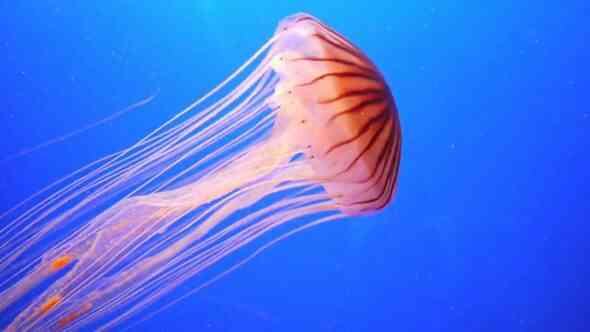Jellyfish — one of the oldest living beings on earth. Among them there are both completely harmless and deadly, capable of killing a person with a single touch. Some aquarists even keep jellyfish at home, enjoying watching their measured movements.
Interesting facts about jellyfish
- The first jellyfish appeared on Earth about 650 million years ago, long before the dinosaurs.
- They are found not only in salt water, but also in fresh water. But all freshwater jellyfish are completely harmless — they can’t sting.
- Jellyfish are found in all oceans and seas (interesting facts about the seas).
- The body of these creatures consists of about 95-98 percent water, depending on the species.
- There are about 10 thousand different types of jellyfish in the world.
- They have no brain, no heart, no blood.
- The life cycle of a jellyfish begins with a polyp, which after a few months or years turns into a jellyfish. In much the same way, a caterpillar turns into a chrysalis, and then into a butterfly.
- Some of their species live at a depth of more than 10 kilometers, which makes them very difficult to study.
- One of the most dangerous, according to statistics, jellyfish — sea wasp, a small jellyfish with long three-meter tentacles. Its touch is usually fatal, and in the last half century alone, representatives of this species have claimed the lives of more than five thousand people.
- Jellyfish have 24 eyes that provide a circular view (interesting facts about the eyes).
- The stinging cells of many poisonous jellyfish retain the ability to sting even if the jellyfish has been washed ashore, dried up and lain there for several months.
- Medusa turitopsis nutrikula — the only truly immortal living being on Earth. When its life cycle comes to an end, it sinks to the bottom and again turns into a polyp, and then back into a jellyfish. If not for natural enemies, these jellyfish would fill all the oceans.
- The largest jellyfish in the world — giant antarctic. The diameter of its dome reaches three meters, and the length of the tentacles — 35 meters (interesting facts about Antarctica).
- These creatures receive oxygen from the water with the entire surface of the body.
- In some Asian countries they are eaten.
- In the ocean country of Palau has Jellyfish Lake, where more than two million of these creatures live — they have bred so much because of the absence of natural enemies. For the same reason, over hundreds and thousands of years, their stinging cells have atrophied (interesting facts about Palau).
- Some types of jellyfish can lay more than 40 thousand eggs per day.
- Nomura jellyfish weighs up to 200 kilograms, and the diameter of its dome sometimes exceeds two meters.
- The spotted Australian jellyfish passes up to 13 tons of water through its body per day.
